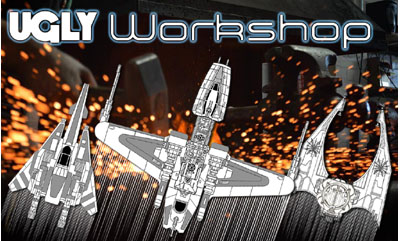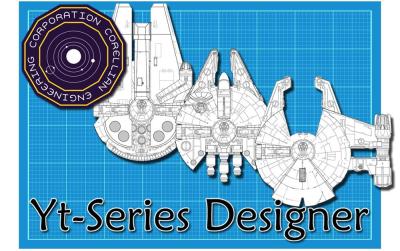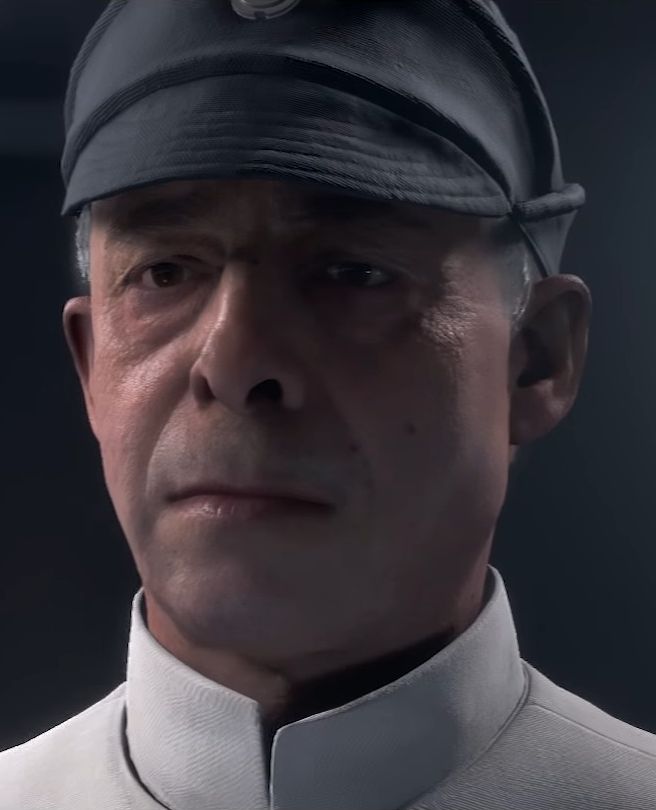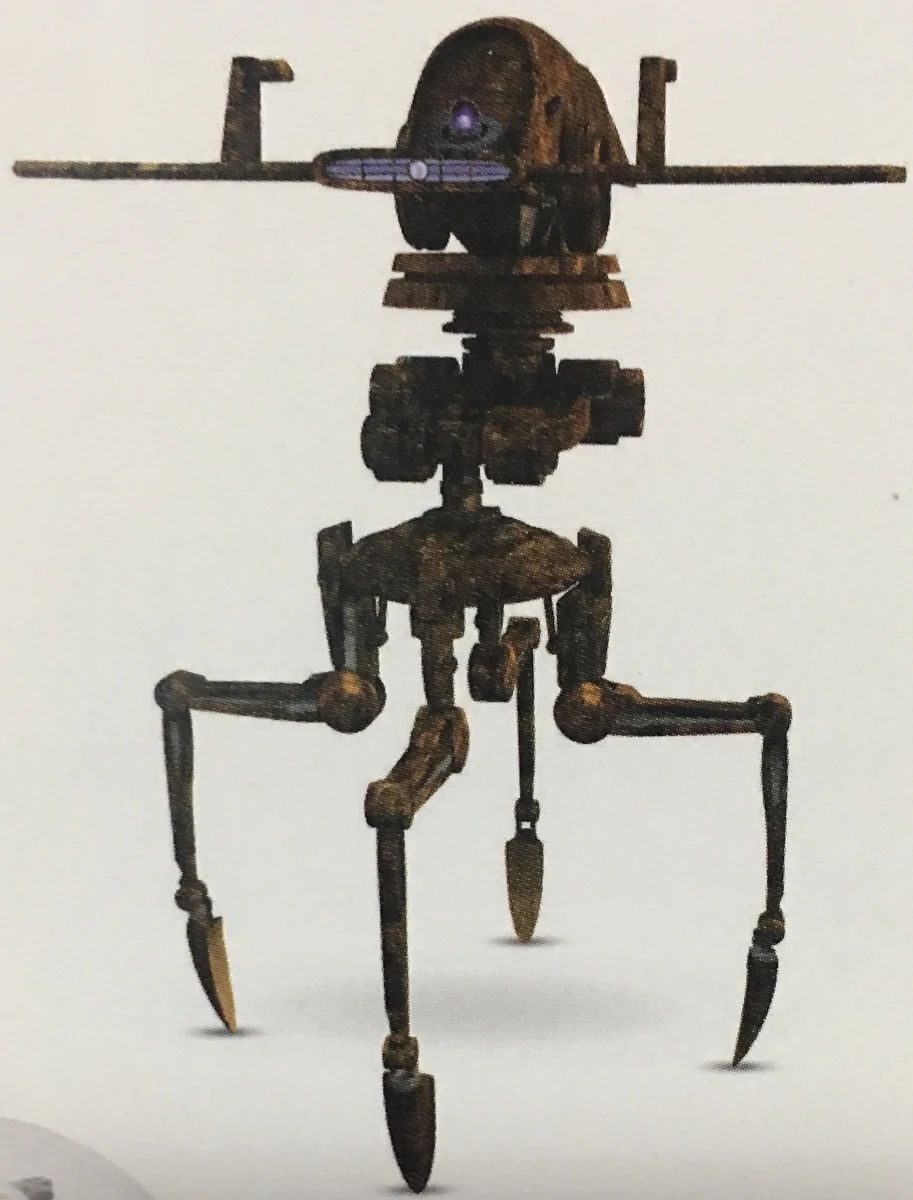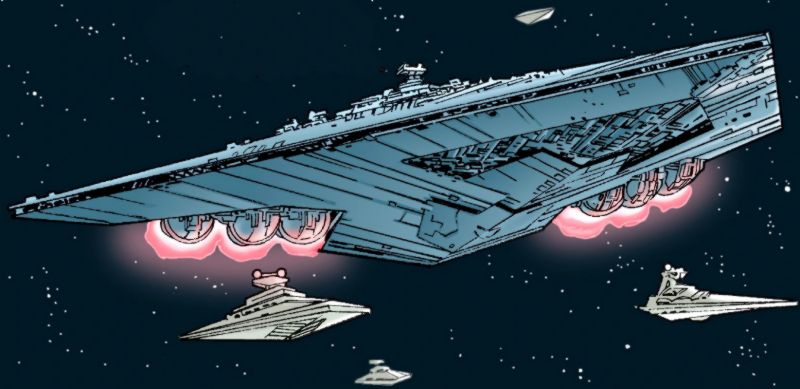 Name: Kuat Drive Yards Executor-class Star Dreadnought
Type: Star Dreadnought
Scale: Capital
Length: 19,000 meters
Skill: Capital Ship Piloting
Crew: Crew (279,144), Gunners (1,590) / Skeleton: 50,000/+10
Passengers: 38,000 troops
Cargo Capacity: 250,000 tons
Consumables: 6 years
Hyperdrive Multiplier: x2
Hyperdrive Backup: x10
Nav Computer: yes
Maneuverability: 0D
Space: 4
Atmosphere: N/A
Hull: 15D
Shields: 10D+1
Sensors:
Passive: 250/2D
Scan 350/3D
Search 500/4D
Focus 75/5D
Weapons:
Note that not all Executor-class ships bear the same armaments as one and other.
2,000 Turbolaser Batteries
Fire Arc: 700 Front, 650 Left, 650 Right
Crew: 1 (500), 2 (750)
Fire Control: 1D
Space Range: 3-15/35/75
Damage: 7D
2,000 Heavy Turbolaser Batteries
Fire Arc: 700 Front, 650 Left, 650 Right,
Crew: 2
Fire Control: 0D
Space Range: 5-20/40/60
Damage: 10D
250 Assault concussion missile tubes (30 Missiles Each)
Fire Arc: 75 Front, 75 Left, 75 Right, 25 Rear
Crew: 1
Fire Control: 2D
Space Range: 2-12/30/60
Damage: 9D
250 Heavy Ion Cannons
Fire Arc: 75 Front, 75 Left, 75 Right, 25 Rear
Crew: 1 (500), 2 (750)
Fire Control: 4D
Space Range: 1-10/25/50
Damage: 4D
40 Phylon Transport Q7 tractor beam projectors
Fire Arc: 10 Front, 5 Left, 5 Right
Crew: 1
Fire Control: 4D
Space Range: 1-5/15/30
Damage: 9D
500 Point Defense Laser Batteries
Fire Arc: 100 Front, 150 Left, 150 Right, 100 Rear
Scale: Starship
Crew: 2
Fire Control: 3D
Space Range: 1-3/12/25
Damage: 6D
Complement:
TIE Series starfighters (144) (can number in the thousands if fully loaded)
AT-ATs (30)
AT-STs (40)
Prefabricated garrison bases (3)
Various other assault and support craft (total of 200)
Description: The Executor-class Star Dreadnought, colloquially known as the Executor-class Super Star Destroyer, Executor-class Star Destroyer or simply Super Star Destroyer, was a heavy warship class in the Star Dreadnought league, often used as command ships and flagships in the Imperial Navy. At their prime, they were among the largest vessels in the galaxy, and were almost invincible in combat, although they were costly to operate.
Characteristics
Like most KDY-style warships, the ship's overall shape was pointed, although unlike the Imperial-class, the Executor-class was closer to dagger-shaped. It also retained the KDY-style command bridge and possessed a massive cityscape on the top and, to a certain degree, at the aft. Its primary colors were dark gray and white for the main hull, and black for the cityscape sections, although the various lights aboard the vessel combined with operating in deep-space environments at times gave a more cerulean appearance to its hull.
Dimensions
The Executor-class measured 19 kilometers in length and was 12 times more massive than the ubiquitous Imperial-class Star Destroyer.
280,734 Imperial Navy officers, gunners and enlisted men were said to have crewed each vessel. The Rebel leader Mon Mothma, when learning of the staff required to man such a vessel, admitted it would be virtually impossible to command it, even if the Rebellion were to somehow capture it, due to there not being enough personnel on their end.
Though several variants of the Executor-class existed, all followed similar design attributes in terms of structure. In terms of length, it was also tied with the Vengeance-class dreadnought as the largest ship class within Star Dreadnoughts or Super Star Destroyers.
Propulsion systems
The Executor-class was built with one main reactor and an unknown number of secondary reactors that could keep life support and other systems running but not propulsion. Thirteen Executor-50.x engines placed in five thruster banks gave the Executor-class impressive acceleration for its size. The main reactor was accessible through various service tubes.
Offensive and defensive systems
The Executor-class had over 5,000 weapons emplacements, including turbolasers, assault concussion missile launchers, and ion cannons. With warships able to direct all power to their energy weapons, the Executor-class had at least 100 times more firepower than an Imperial-class destroyer.
A majority of gun batteries and missile launchers were located in the central cityscape on the class's dorsal side, while some point-defense guns were located throughout the side trenches. On at least one ship, many heavy batteries were sacrificed for an increased number of anti-starfighter cannons.
Despite its impressive firepower, the design was far from perfect, as the ventral side and the aft were relatively undefended, and Executor-class SSDs required an impressive starfighter defensive screen to chase off enemy starfighters and marauding smaller capital ships who otherwise could remain in the main weaponry's blind spots. In addition, the Executor-class possessed several trenches in its cityscape, which also left it vulnerable to the Trench Run Defense tactic should its shields be disabled. Such a weakness is what destroyed an in-development variant possessing cloaking abilities at Fondor, and is ultimately what destroyed the Executor at Endor.
Its shields handled much of the power generated—an amount equivalent to the total power of a medium star (3.8 × 1026 W). Shield projectors were placed throughout the hull, which decentralized the protection system and decreased the chance of all shields falling at once. Known shield segments included the dorsal, ventral, bow, aft, port and starboard shields. In later-model ships, an extra shield generator was mounted in the middle of the ship.
In addition to the shield generators, several Executors had cloaking generators or stealth armor fitted to the vessel, in order to perform sneak attacks on enemy targets.
Sensor domes
The geodesic domes located on and around the Executor's bridge tower (similar to those of Imperial-class Star Destroyers) served dual purposes. Inside the dome were hyperwave transceiver coils for supralight active sensors, while vanes jutting out of the dome served as shield projectors for the surrounding area. There were many such geodesic domes scattered around the ship. The ship also possessed long-range scanners, which also ensured, alongside Viper probe droids, that the Executor could locate Echo base.
These domes were not vulnerable to external attack as long as the shields remained intact, but concentrated capital-ship bombardment—such as that ordered by Admiral Gial Ackbar during the Battle of Endor—could knock out this protective field. The sensors and shield projectors thus became vulnerable to attack, as demonstrated by Rebel starfighter pilots.
Complement
A minimum of 144 starfighters were carried on board Executor-class vessels, but the massive hangars could hold thousands. In addition to fighters, the Executor-class also carried a large number of landing craft, dropships, ground armor and up to three prefabricated garrison bases.
At least three hangar bays were located on the portside, several underneath the vessel and multi-level fighter bays deep inside the main superstructure. The class had an internal Beltway cargo handling system. The internal freight shaft went from the stern to the prow of the battleship, equipped with a tracked hauler that could carry large loads throughout the vessel.
These Super-class Star Destroyers possessed six detention blocks that were used for crew discipline alone. They held ten additional high-security blocks that were used for enemy prisoners. Furthermore, they contained three cargo areas that were designed for the secure transport of large quantities of slaves, refugees or even prisoners of war. Adjacent to the large landing bays used by the bulk shuttles were holding areas that were equipped with only minimal facilities in terms of water taps, ventilation and food dispensers. These regions of the ship were considered adequate for up to a thousand people.
Bridge
The bridge tower was almost a starship in itself and was a standard module on many different KDY warship classes. It was equipped with heavy shielding to compensate for its highly visible location, and contained mess halls, special quarters for officers of high rank, and large escape pods. The admiral aboard the vessel even had his own escape pod, directly above the command bridge and next to admiral's suites. The command tower also had its own power generators, relays, and life-support systems. It was connected to the ship's main reactor by a cluster of power feeds. The tower's shaft was also littered with thin flaps that had a variety of purposes, including heat-sink panels, small radiators, antennas, and even defensive cannons on occasion.
The bridge of the Executor had the same basic layout as standard Star Destroyers. The outermost part featured nine triangular viewports. The center contained two crewpits which housed the control consoles for the ship, of which there were six consoles for each crew pit. As the crewpits inhibited the flight data officers, tracking systems specialists, and combat supervisors' ability to see through the bridge's viewport, the crew focused on their consoles without unnecessary distraction. Between them was the command walkway. To the right and left sides of the bridge were two alcoves containing the weapons and defense stations, which were located to the right and left of the hall, respectively, and likewise were placed near minor viewports. Behind the bridge was the Security Foyer, which contained the communications stations on the leftmost wall, a turbolift, and a HoloNet pod for ship-to-ship communications at the center. Immediately behind the Security Foyer was a series of steps that led directly to the main corridor, with the immediate entryway to the corridor possessing access doorways to each side. On the level directly beneath the bridge was the main navigation complex.
Additional tower structures were located throughout the ship's main superstructure, including a forward structure similar in design to the Munificent-class Star Frigate's command tower.
History
Design and construction
The Executor-class was the brainchild of Lira Wessex, the brilliant and ambitious engineer who already had the designs of the Venator-class and Imperator-class (later renamed Imperial-class) Star Destroyers to her credit. Following her work on the already-impressive Imperial-class, Wessex sought to improve on the design.
Adhering to Kuat Drive Yards' philosophy of psychological effect in starship design, or "terror styling," she believed that the immense size of an Imperial-class Star Destroyer was largely responsible for its ability to intimidate opponents. Working on that theory, she began designing a starship that would dwarf all her previous works. Though KDY had designed and built extremely large warships in the past, such as Star Dreadnoughts like the Mandator-class and battlecruisers like the Procurator-class, the result obtained by Wessex was utterly gargantuan. Although the ship was developed by Kuat Drive Yards, the Emperor commissioned Fondor Shipyards to finish the lead ship, much to Fondor's consternation, as they had to put several civilian ship designs on hold. Their anger grew worse when it became apparent that Kuat Drive Yards would continue development of all future Super Star Destroyer models, as they hoped this would act as an opportunity to steal future design grants from their business rival. In addition, Kuat was also commissioned to develop a second Executor-class in secret, in order to get away with stating that the ship was developed in both Kuat and Fondor.
Emperor Palpatine authorized the construction of the first four Executor-class ships even before the Battle of Yavin (0 BBY), but it still had to be slipped past the watchful eyes of various oversight committees in the Imperial Senate; to the very last, the minority of Senators who opposed Palpatine and his policies used the few political tools they had left to hinder him, and one of these was budget oversight. To conceal the particulars of the vessel from the opposition, the Navy listed the new ship as a "Super-class Star Destroyer" in budget reports submitted to the Senate, and understated its true length (19,000 meters) by many kilometers.
Owing to this, the Executor-class and other ships of its range in size came to be unofficially classed "Super Star Destroyers." The ship's length, even in Imperial government scandocs, was variously reported as 8,000 or 12,800 meters, before the true details of the size of the class came to light.
The first of the class, the Executor, began construction in the years preceding the Battle of Yavin. The unfinished vessel was used as a headquarters for Darth Vader and his secret apprentice, Galen Marek. With the sudden and unanticipated destruction of the Death Star at Yavin, Wessex's production schedule changed completely. At the urging of Darth Vader, the Emperor ordered her to rush the new line into production as quickly as possible, to compensate for the loss of the battle station. As certain segments of naval command may have anticipated, a new symbol of intimidation was needed, and as Wessex had believed, the Executor-class fit the need well.
The first two Executor-class ships were now being built simultaneously, with the Lusankya at Kuat Drive Yards and the Executor moved to the Fondor Shipyards. Darth Vader received the finished Executor at Fondor about half a year after the fiasco at Yavin. The second ship, then known as the Executor II, was completed shortly afterwards at Kuat, received its new name, and was hidden on Coruscant.
Imperial service
The Executor went on to become the most feared and famous of its class by virtue of its status as Darth Vader's command ship. Because of the Executor's stance as the lead ship of Darth Vader's fleet, Death Squadron, Death Squadron's fleet insignia also bore the image of an Executor-class Star Dreadnought. In addition, four Executor-class Star Dreadnoughts, including the Executor itself, were known to have been in service to the Empire by the time of the Battle of Hoth in 3 ABY. However, the vessel was destroyed at the Battle of Endor in 4 ABY, after an A-wing starfighter rammed through its bridge and it subsequently crashed into the Death Star II.
During the early years of the Galactic Civil War, several other Executor-class ships were built and fielded. A Rebel strike destroyed an Executor-class ship, upgraded with cloaking technology, while still under construction at Fondor in 3 ABY. Another Star Dreadnaught with cloaking capability, the Terror, was already operational by 3 ABY. The Vengeance led a task force around this time. Towards the end of Palpatine's glory days in 4 ABY, other Executors were noted as well. The Guardian was tasked with protecting Coruscant, the Annihilator served close to Kuat, the Reaper led Scourge Squadron on its patrols in the Outer Rim Territories and the Brawl was given to Admiral Zsinj by Palpatine himself.
In the later years, production on Executor-class Star Dreadnoughts and other Super Star Destroyers accelerated in a display of the Emperor's wealth and power. After the death of the Emperor and the fragmentation of the Galactic Empire into feuding fiefs, Executor-class Star Dreadnoughts were popular acquisitions amongst warlords hoping to improve their military power and prestige. Some would fall into the hands of the New Republic, where they would fight against the Empire they had once served. The Imperial Warlord Superior General Sander Delvardus had a new Executor-class Star Dreadnought constructed at great expense and it was completed in 12 ABY. It was named the Night Hammer and was soon taken by Admiral Natasi Daala as her flagship. She renamed it the Knight Hammer and led it in an attack against the Jedi Praxeum on Yavin 4. However, it was destroyed by the Jedi Callista Ming.
Legacy
Following the Black Fleet Crisis, where the New Republic faced the Star Dreadnought Intimidator, a decision was made to build a warship class that could counter threats from rogue warships like the Executor-class. The result was the Star Dreadnought-analogue Viscount-class Star Defender built by the Mon Calamari.
In addition to these Star Defenders, the few Executor-class Star Dreadnoughts left after the Galactic Civil War would see heavy action in the Yuuzhan Vong War, where even more ships were lost. After the war, the only known Star Dreadnought left and operating under the Galactic Alliance was the Guardian, which was present at the Battle of Yuuzhan'tar, and later returned to its post at Kashyyyk, following the war's end.
By the Sith–Imperial War, the Executor-class was gone from active service, having been found too expensive to run. It shared this fate with many other heavy warship designs, as fleet doctrine moved towards smaller, compact weapons platforms, like the MC140 Scythe-class main battle cruiser. The final legacy of the Executor-class was its partial inspiration for the Pellaeon-class Star Destroyer, which incorporated systems from both it and the Imperial-class Star Destroyer.
|






